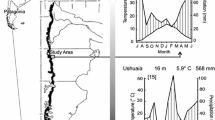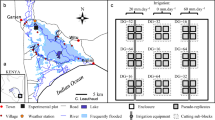Abstract
We assessed the growth and survival of a willow clone (Salix matsudana × Salix alba ‘A 13/44’) growing under different vegetation management in the flooded area of the Parana River Delta (Argentina) during the first 2 years after planting. Treatments consisted in a combination of practices applied in the row and in the inter-row. In the row (1-m wide) vegetation was manually cut with machete (r-M), treated with glyphosate at 3% (r-H) or maintained undisturbed (r-U); in the inter-row vegetation was crushed with a roller (I-R), treated with glyphosate at 3% (I-H) or maintained undisturbed (I-U). Height, diameter and relative growth rate of the dominant sprout were evaluated. Tree survival was high (96%) and not affected by treatments. Growth was modified by the vegetation control at early stages. Height and diameter were higher in r-H plots compared to r-U plots; both were similar in the I-U and I-H plots but greater than in I-R plots. Early differences in diameter relative growth rate among row treatments were found. Possible mechanisms associated with willow growth responses such as plastic responses under resource limited conditions and amelioration of the microenvironment by the native vegetation are discussed.



Similar content being viewed by others
References
Adams P, Beadle C, Mendham N, Smethurst P (2003) The impact of timing and duration of grass control on growth of a young Eucalyptus globulus Labill. plantation. New Forests 26:147–165
Aphalo P, Ballaré C (1995) On the importance of information-acquiring systems in plant–plant interactions. Funct Ecol 9:5–14
Balandier P, Collet C, Miller J, Reynolds P, Zedaker S (2006) Designing forest vegetation management strategies based on the mechanisms and dynamics of crop tree competition by neighbouring vegetation. Forestry 79:3–27
Ballaré C, Sánchez R, Scopel A, Casal J, Ghersa C (1987) Early detection of neighbor plants by phytochrome perception of spectral changes in reflected sunlight. Plant Cell Environ 10:551–557
Berrondo G, Gurini L (1990) Características ecológicas del Delta del Río Paraná. Boletín de Divulgación de la E.E.A Inta Delta del Paraná. INTA. 9 p
Birk J (1998) Herbicide registration and labeling for use in short rotation woody crops. In Proceedings of the short-rotation woody crops operation working group. Vancouver, Washington, USA, pp 89–91
Bonetto A, Hurtado S (1998) Delta Paranense. Región 1 Cuenca del Plata. In: Canevari P, Blanco D, Bucher E, Castro G, Davidson I (eds) Los humedales de la Argentina. Situación actual, conservación y legislación. Wetlands Intern. Publ. 46, pp 31–72
Borodowski E, Suárez R (2005) Caracterización forestal de la región del Delta del Paraná. Documento NEF Delta. Proyecto Forestal de Desarrollo, Secretaría de Agricultura, Ganadería, Pesca y Alimentación, 8 p
Buresh R, Austin E, Craswell E (1982) Analytical methods in N15 research. Fert Res 3:37–62
Burkart A (1957) La vegetación del Delta del Río Paraná. Darwiniana 11:457–562
Callaway R (1992) Effect of shrubs on recruitment of Quercus douglasii and Quercus lobata in California. Ecology 73:2118–2128
Crawley MJ (1993) GLIM for ecologists. Blackwell Scientific Publications, Oxford
Cozzo D (1995) Silvicultura de las plantaciones maderables. ed. Orientación Gráfica, Tomo II, pp 433–445
Gilbert I, Seavers G, Jaarvis P, Smith H (1995) Photomorphogenesis and canopy dynamics. Phytochrome-mediated proximity perception accounts for the growth dynamics of canopies of Populus trichocarpa × deltoides “Beaupre”. Plant Cell Environ 18:475–497
Goldberg D (1996) Simplifying the study of competition at the individual plant level: consequences of distinguishing between competitive effect and response for forest vegetation management. New Zeal For Res 26:19–38
Groot A (1999) Effects of shelter and competition on the early growth of planted white spruce (Picea glauca). Can J For Res 29:1002–1014
Holmgren M, Scheffer M, Huston MA (1997) The interplay between facilitation and competition in plant communities. Ecology 78:1966–1975
Hunt R (1990) Basic growth analysis. Plant growth analysis for beginners. Unwin Hyman Ltd., London
INTA Instituto Nacional de Tecnología Agropecuaria (1990) Atlas de suelos de la República Argentina. Tomo I. Secretaría de Agricultura, Ganadería y Pesca. Proyecto PNUD Arg 85/019. Centro de Investigaciones en Recursos Naturales
Kopinga J, van del Burg J (1995) Using soil and foliar analysis to diagnose the nutritional status of urban trees. J Arboric 21:17–24
Kozlowski T, Kramer P, Pallardy S (1991) The physiological ecology of woody plants. Academic Press, Nueva York
Little K, Van Staden J, Clarke G (2003) Eucalyptus grandis × E. camaldulensis variability and intra-genotypic competition as a function of different vegetation management treatments. New Forest 25:227–242
Malvarez A (1999) El Delta del Río Paraná como mosaico de humedales. In: Malvarez A (ed) Tópicos sobre humedales subtropicales y templados de Sudamérica. UNESCO, pp 35–53
McCullagh P, Nelder JA (1989) Generalized linear models. Second edn. Chapman and Hall, London
Meadows J, Stanturf J (1997) Silvicultural systems for southern bottomland hardwood forests. For Ecol Manage 90:127–140
Miller J, Boyd R, Boyd Edwards M (1999) Floristic diversity, stand structure and composition 11 years after herbicide site preparation. Can J For Res 29:1073–1083
Murphy J, Riley J (1962) A modified single solution method for determination of phosphate in natural waters. Anal Chim Acta 27:31–36
Nambiar E, Sands R (1993) Competition for water and nutrients in forests. Can J For Res 23:1955–1668
Orlander G, Nilsson U, Hallgren J (1996) Competition for water and nutrients between ground vegetation and planted Picea abies. New Zeal For Res 26:99–117
Powell G, Bork E (2004) Competition and facilitation in mixtures of aspen seedlings, alfalfa, and marsh reedgrass. Can J For Res 34:1858–1869
Ratcliff A, Busse M, Shestak C (2006) Changes in microbial community structure following herbicide (glyphosate) additions to forest soils. Appl Soil Ecol 34:114–124
Rey Benayas J, Lopez-Pintor A, García C, de la Cámara N, Strasser R, Gómez Sal A (2002) Early establishment of planted Retama sphaerocarpa seedlings under different levels of light, water and weed competition. Plant Ecol 159:201–209
Richards LA (1954) Diagnosis and improvement of saline and alkali soils. USDA Agric Handbook 60, Washington, DC
Ritchie G (1997) Evidence for red: far red signalling and photomorphogenic growth response in Douglas-fir (Pseudotsuga menziessi) seedlings. Tree Physiol 17:161–168
Roth B, Newton M (1996) Survival and growth of Douglas-fir relating to weeding, fertilization, and seed source. West J Appl For 11(2):62–69
Sage R (1999) Weed competition in willow coppice crops: the cause and extent of yield losses. Weed Res 39:399–411
SAGPYA Secretaría de Agricultura, Ganadería, Pesca y Alimentación (2001) Inventario Nacional de Plantaciones forestales. Proyecto Forestal de Desarrollo, 63 p
SAS Institute (1996) SAS system for Windows, release 6.12. SAS Institute, Inc., Cary, NC
Schumann A, Little K, Snell C (1994) Recommendations on establishment weeding intensity in Zululand: updated 15 month results from three competition trials and simulation models. ICFR Bulletin Series 3/94:1–8
Sparling D, Matson C, Bickham J, Doelling-Brown P (2006) Toxicity of glyphosate Glypro ® and LI700 to red-eared sliders (Trachemys-scripta elegans) embryos and early hatchlings. Environ Tox Chem 25:2768–2774
Statistix 8.0 for Windows. Analytical software, Tallahassee, Fl, USA
Steel R, Torrie J (1986) Bioestadística: Principios y procedimientos. McGraw Hill, México
Tage T, Suzuki M, Yagi H (1996) Site quality and the competition between weeds and planted seedlings in relation to weeding. New Zeal For Res 26:118–125
Ter-Mikaelian M, Wagner R, Wayne Bell F, Shropshire C (1999) Comparison of photosynthetically active radiation and cover estimation for measuring the effects of interspecific competition on jack pine seedlings. Can J For Res 29:883–889
Tinoco-Ojanguren C, Pearcy R (1995) A comparison of light quality and quantity effects on the growth and steady-state and dynamic photosynthetic characteristics of three tropical tree species. Func Ecol 9:222–230
Toledo R, Victoria Filho R, Alves P, Pitelli R, Freitas Lopes M (2003) Faixas de controle de plantas daninhas e seus reflexos no crescimento de plantas de eucalipto. Scient For 64:78–92
Volk T, Robinson D, Abrahmson L (2000) Alternative methods of site preparation for willow and poplar biomass crops in the northeastern United States. In: Proceedings of the 21st session of the international poplar commission (IPC 2000) Poplar and Willow Culture: Meeting the needs of society and the environment, p 196
Wagner R, Radosevich S (1991) Neighborhood predictors of interspecific competition in young Douglas-fir plantations. Can J For Res 21:821–828
Wagner R, Radosevich S (1998) Neighborhood approach for quantifying interspecific competition in Coast Oregon Forest. Ecol Appl 8 3:779–794
Wagner R, Noland T, Mohammed G (1996) Timing and duration of herbaceous vegetation control around four northern coniferous species. New Zeal For Res 26:39–52
Wagner R, Mohammed G, Noland T (1999) Critical period of interspecific competition for northern conifers associated with herbaceous vegetation. Can J For Res 29:890–897
Wagner R, Little K, Richardson B, McNabb K (2006) The role of vegetation management for enhancing productivity of the world’s forests. Forestry 79:57–79
Waring R, Schlesinger W (1985) Forest ecosystems. Concepts and management. Academic Press, New York
Warrington I, Rook D, Morgan D, Turnbull H (1989) The influence of simulated shadelight and daylight on growth, development and photosynthesis of Pinus radiata, Agathis australis and Dacrydium cupressinum. Plan Cell Environ 12:343–356
Woods P, Nambiar E, Smethurst P (1992) Effect of annual weeds on water and nitrogen availability to Pinus radiata trees in a young plantation. For Ecol Manage 48:145–163
Acknowledgements
This research was supported by grants from UBACYT TG 039 (Science and Technology of the University of Buenos Aires) and SAGPYA Project PIA 16/04 (Argentinean Secretary of Agriculture, Husbandry, Fisheries and Food).
Author information
Authors and Affiliations
Corresponding author
Rights and permissions
About this article
Cite this article
Garau, A.M., Caccia, F.D. & Guarnaschelli, A.B. Impact of standing vegetation on early establishment of willow cuttings in the flooded area of the Parana River Delta (Argentina). New Forests 36, 79–91 (2008). https://doi.org/10.1007/s11056-008-9083-x
Received:
Accepted:
Published:
Issue Date:
DOI: https://doi.org/10.1007/s11056-008-9083-x




